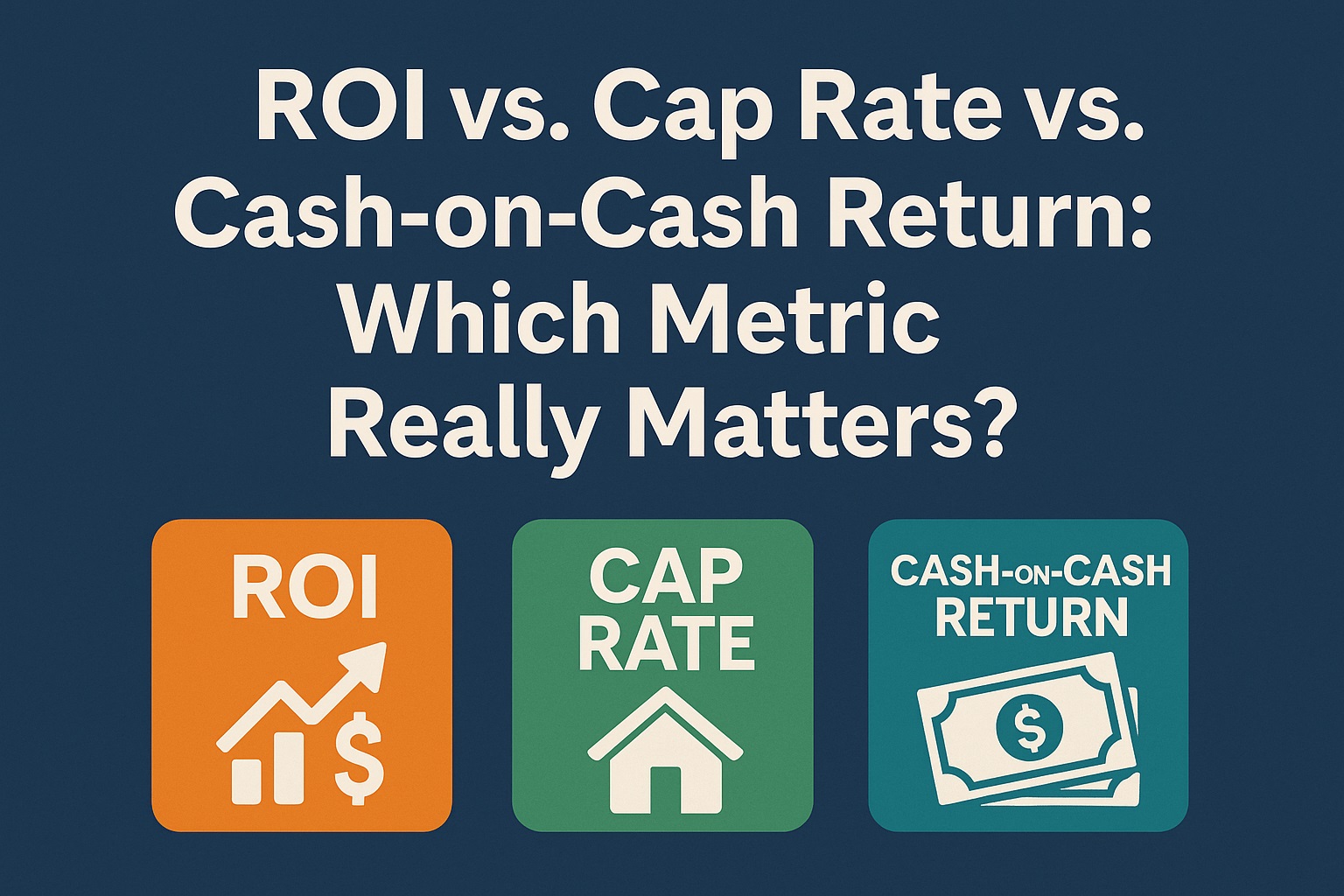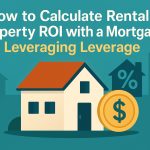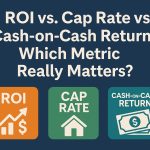Investing in rental properties can feel like navigating a maze of formulas, jargon, and seemingly endless “what-if” scenarios. Yet, at the heart of every smart real estate decision lies one truth: you need the right metric to measure success. While rental property ROI often grabs the spotlight, savvy investors know that Cap Rate and Cash-on-Cash Return each tell a unique part of the story.
- ROI (Return on Investment) reveals your overall profit as a percentage of your cash outlay.
- Cap Rate offers a quick “snapshot” of yield based purely on net operating income and purchase price.
- Cash-on-Cash Return zeroes in on the actual cash you pocket each year relative to your down payment.
In this article, you’ll learn:
- Why one metric isn’t enough—and how using all three leads to better buying and holding decisions.
- The exact formulas for ROI, Cap Rate, and Cash-on-Cash Return (complete with real-world examples).
- When each metric shines—and when it can mislead you if you rely on it alone.
By the end, you’ll be armed with the knowledge to build a rental property dashboard that gives you a clear, holistic view of performance—empowering you to compare properties, stress-test scenarios, and maximize your long-term gains.
2. What Is ROI (Return on Investment)?
2.1 Definition & Formula
Return on Investment (ROI) measures how much profit you make relative to the total cash you’ve invested. In its simplest form:
mathematicaCopyEditROI (%) = (Net Profit ÷ Total Cash Invested) × 100
- Net Profit = Total Rental Income – All Expenses (mortgage payments, taxes, insurance, maintenance, vacancies).
- Total Cash Invested = Down Payment + Closing Costs + Initial Repairs.
Example: You buy a rental for $200,000 with a 20% down payment ($40,000), $5,000 in closing costs, and $10,000 in repairs. Over the first year, you collect $18,000 in rent and pay $8,000 in combined expenses.
- Net Profit = $18,000 – $8,000 = $10,000
- Total Cash Invested = $40,000 + $5,000 + $10,000 = $55,000
- ROI = (10,000 ÷ 55,000) × 100 ≈ 18.2%
2.2 Strengths & Weaknesses
| Strengths | Weaknesses |
|---|---|
| • Universal Comparison: Works across assets. | • Time Value Ignored: Doesn’t factor in cash timing. |
| • Simplicity: One formula, clear percentage. | • Leverage Effects: Can hide financing risks. |
| • Equity Growth Focus: Shows total return. | • After-Tax Variations: Doesn’t include tax impacts. |
2.3 When to Use ROI
- Long-Term Hold: Ideal for buy-and-hold investors comparing multiple properties over 5–10+ years.
- Equity Growth Tracking: Best if your goal is maximizing total appreciation and cash flow combined.
- Cross-Asset Analysis: Use ROI to compare rental real estate against stocks, bonds, or REITs.
3. Understanding Cap Rate (Capitalization Rate)
3.1 Definition & Formula
The Capitalization Rate (Cap Rate) measures a property’s unleveraged yield based solely on its Net Operating Income (NOI) and current market value. It’s calculated as:
mathematicaCopyEditCap Rate (%) = (Net Operating Income ÷ Property Value) × 100
- Net Operating Income (NOI) = Gross Rental Income – Operating Expenses (taxes, insurance, maintenance, property management, vacancy allowance).
- Property Value = Purchase price or current market valuation.
SEO Tip: Include “cap rate” and “rental property cap rate” in your image alt-tags and headings (e.g.,
alt="Example cap rate calculation for rental property").
3.2 Worked Example
Imagine you purchase a rental home for $250,000. Over the first year:
- Gross Rental Income = $24,000
- Operating Expenses =
- Property Taxes: $2,500
- Insurance: $1,200
- Maintenance & Repairs: $1,800
- Property Management Fee (8%): $1,920
- Vacancy Allowance (5% of rent): $1,200
- Total Expenses = $8,620
- NOI = $24,000 – $8,620 = $15,380
Now compute Cap Rate:
javaCopyEditCap Rate = (15,380 ÷ 250,000) × 100 ≈ 6.15%A 6.15% Cap Rate tells you this property would yield roughly 6.15% per year on an all-cash basis, before financing or taxes.
Pro SEO Note: Embed the related long-tail keyword “calculate cap rate rental property” in a subheading or opening sentence of this example.
3.3 Strengths & Weaknesses
Strengths Weaknesses • Quick Comparison: Lets you rank multiple properties by yield. • No Financing Consideration: Ignores debt costs. • Market Snapshot: Reflects current income performance in one metric. • Static Measure: Only a single year’s NOI is used. • Easy to Benchmark: Compare against market averages in your city or neighborhood. • Ignores Tax & Depreciation Effects: Doesn’t adjust for after-tax returns.
- Strength Insight: For investors looking at multiple properties side-by-side—especially in the same submarket—Cap Rate is invaluable for a quick apples-to-apples comparison.
- Weakness Caveat: Because it excludes financing, two identical properties could show the same Cap Rate but deliver very different cash flows if one is 100% cash-purchased and the other heavily mortgaged.
SEO Tip: Use a bulleted list or table for pros/cons to improve dwell time and clarity, aligning with “cap rate pros and cons” search intent.
3.4 When to Use Cap Rate
- Initial Property Screen: During the early research phase, filter out deals that don’t meet your minimum yield threshold (e.g., 5%+ Cap Rate).
- Market Trend Analysis: Track aggregate Cap Rates over time to spot rising or falling rental demand in specific neighborhoods.
- Valuation Cross-Check: Validate your purchase price by ensuring the implied Cap Rate aligns with comparable sales.
Practical Tip: Always verify that the NOI figures you’re using are normalized (i.e., adjusted for unusually high one-off expenses or vacancy spikes) to avoid misleading Cap Rate calculations.
4. Cash-on-Cash Return Explained
4.1 Definition & Formula
Cash-on-Cash Return measures the annual before-tax cash flow you actually receive as a percentage of your total cash invested. It’s particularly insightful for investors using leverage:
mathematicaCopyEditCash-on-Cash Return (%) = (Annual Before-Tax Cash Flow ÷ Total Cash Invested) × 100
- Annual Before-Tax Cash Flow = NOI – Annual Debt Service (principal + interest).
- Total Cash Invested = Down Payment + Closing Costs + Initial Repairs.
SEO Tip: Place “cash-on-cash return rental property” in the first 100 words and again in at least one subheading.
4.2 Detailed Worked Example with Mortgage
Let’s revisit the $250,000 property, but this time you finance 75% with a 30-year fixed loan at 4.5% interest:
- Purchase Price = $250,000
- Loan Amount = $187,500 (75% LTV)
- Down Payment = $62,500
- Closing Costs = $5,000
- Repairs = $7,500
- Total Cash Invested = $62,500 + $5,000 + $7,500 = $75,000
From section 3.2, we know NOI = $15,380. Now calculate Annual Debt Service:
nginxCopyEditMonthly Mortgage Payment ≈ \$949 Annual Debt Service = 949 × 12 = \$11,388
- Annual Before-Tax Cash Flow = $15,380 – $11,388 = $3,992
Now compute Cash-on-Cash Return:
vbnetCopyEditCash-on-Cash Return = (3,992 ÷ 75,000) × 100 ≈ 5.32%This 5.32% metric reflects real cash profit on your actual cash outlay, showing how financing reduces your immediate yield compared to an all-cash purchase.
SEO Tip: Offer a free downloadable Cash-on-Cash calculator (Excel or Google Sheets) in exchange for email capture to boost user engagement and dwell time.
4.3 Strengths & Weaknesses
Strengths Weaknesses • Reflects Actual Cash Flow: Shows real-world yield after debt service. • Interest Rate Sensitivity: A small rate change can drastically alter yield. • Comparative Clarity: Easy to compare financed deals. • Ignores Equity Build-Up: Does not account for principal pay-down over time. • Focus on Liquidity: Ideal for investors prioritizing cash flow. • Before-Tax Only: Doesn’t include tax benefits like depreciation.
- Strength Insight: Useful for short-term holds where cash flow matters more than appreciation.
- Weakness Caveat: Because it ignores principal repayment, two mortgages with identical rates and terms yield the same Cash-on-Cash, even if one amortizes faster.
SEO Tip: Include “cash-on-cash return vs cap rate” in an FAQ section or H3 subheading to capture comparison searches.
4.4 When to Use Cash-on-Cash Return
- Financed Purchases: Whenever you use a mortgage or creative financing, track this metric to monitor actual cash flow performance.
- Income-Driven Investors: If your goal is monthly positive cash flow (e.g., retirees living off rental income), Cash-on-Cash is your go-to measure.
- Short-Hold & Flip Models: For buy-and-hold-flip hybrids or BRRRR strategies, this metric highlights how quickly your investment returns cash, even if the property isn’t sold immediately.
5. Side-by-Side Comparison
To see how ROI, Cap Rate, and Cash-on-Cash Return differ in practice, consider the following comparison of a hypothetical rental property:
Metric Input Focus Calculation Basis Pros Cons ROI Net profit vs. total cash invested (Net Profit ÷ Total Cash Invested) × 100• Captures total return (cash flow + equity gain) • Easy cross-asset comparison • Ignores timing of cash flows • Does not isolate financing effects Cap Rate Net operating income vs. property value (NOI ÷ Property Value) × 100• Quick yield snapshot • Market valuation check • Excludes financing • Single-year view only Cash-on-Cash Return Annual before-tax cash flow vs. cash outlay (Annual Cash Flow ÷ Total Cash Invested) × 100• Reflects actual cash in pocket • Highlights financing impact • Omits principal pay-down • Ignores tax benefits
- ROI shows your aggregate return, blending rental profits with appreciation.
- Cap Rate isolates property performance independent of how you pay for it.
- Cash-on-Cash zeroes in on the yield you actually pocket each year after mortgage expenses.
Interpreting the Table
- Initial Screening
Use Cap Rate when you want a rapid filter: set a minimum threshold (e.g., 6%) and discard properties below it.- Financing Decisions
Compare Cash-on-Cash between different loan structures to see which mortgage terms deliver the best annual cash yield.- Long-Term Wealth Tracking
Monitor ROI over multiple years to understand how appreciation, principal pay-down, and cash flow combine to grow your equity.
6. Use-Case Scenarios
Every investor has a unique goal and risk tolerance. Below are three common strategies—and the metric that matters most for each:
Scenario A: High-Leverage, Fast-Appreciation Play
Profile: You purchase a property in an up-and-coming neighborhood using a 90% loan-to-value mortgage. You expect significant price growth over 3–5 years.
- Key Focus: Equity growth amplified by leverage.
- Recommended Metric:ROI
- Why? ROI incorporates both cash flow and the appreciation on your leveraged equity. Even if your annual cash flow is modest or slightly negative after mortgage, a large property value increase can drive a stellar ROI.
- Example: A 10% annual appreciation on $200,000 yields $20,000 gain; net rental profit of $5,000 on $15,000 cash invested produces combined ROI of
(25,000 ÷ 15,000) ≈ 167%over one year.
Scenario B: Stable, Cash-Flowing Rental
Profile: You seek predictable monthly income and plan to hold a turnkey single-family home for 10+ years with minimal renovations.
- Key Focus: Reliable, positive cash flow.
- Recommended Metric:Cash-on-Cash Return
- Why? This metric measures your actual annual cash profit relative to your out-of-pocket investment, which is exactly what matters when you rely on rental checks to cover expenses or lifestyle needs.
- Example: $12,000 annual cash flow on $80,000 total investment gives a
(\$12,000 ÷ \$80,000) × 100 = 15%Cash-on-Cash Return.
Scenario C: Value-Add Renovation Project
Profile: You buy a distressed multi-family building below market value, invest $50,000 in upgrades, then raise rents and refinance after stabilization.
- Key Focus: Increase both net operating income and property value.
- Recommended Metrics:Cap Rate initially, then ROI post-renovation
- Pre-Renovation Cap Rate: Ensures the deal offers enough upside—look for a low entry Cap Rate (e.g., 4–5%) to justify renovation risks.
- Post-Renovation ROI: After improvements, calculate ROI to capture combined benefit of higher rent (improved NOI) and increased valuation on your total cash outlay.
- Example:
- Before Renovation: NOI $20,000 on $400,000 purchase → 5% Cap Rate (acceptable for a fixer).
- After Renovation: NOI $30,000, property reappraised at $500,000, total cash invested $150,000 → ROI
((30,000 + 100,000 appreciation) ÷ 150,000) ≈ 87%.7. Combining Metrics for a Holistic View
Relying on a single performance metric can leave blind spots. By viewing ROI, Cap Rate, and Cash-on-Cash Return side by side, you gain a multidimensional understanding of each deal:
- Build a Simple Spreadsheet Dashboard
- Columns: Property Name, Purchase Price, Down Payment, NOI, Annual Cash Flow, Net Profit, Cap Rate, Cash-on-Cash, ROI.
- Formulas:
- Cap Rate = NOI ÷ Purchase Price
- Cash-on-Cash = (NOI – Debt Service) ÷ Total Cash Invested
- ROI = Net Profit ÷ Total Cash Invested
- Color Coding: Highlight cells red, yellow, or green based on thresholds you set for each metric (e.g., Cap Rate ≥ 6%, Cash-on-Cash ≥ 8%, ROI ≥ 15%).
- Interpretation Across Market Cycles
- In a rising market, ROI may inflate quickly due to appreciation, while Cap Rate stays relatively stable if NOI growth lags.
- In a soft market, Cap Rates tend to compress (prices stay high, NOI dips), exposing weaker income fundamentals. Cash-on-Cash then shows whether your mortgage payments remain covered.
- Scenario Modeling with All Three Metrics
- Best-Case: 5% vacancy, 3% annual rent growth, stable expenses. Calculate each metric over a 5-year hold to see total ROI vs. average Cap Rate vs. cash yield.
- Stress Case: 10% vacancy, 1% rent growth, unexpected repair surge. Observe how Cap Rate shrinks, ROI suffers, and Cash-on-Cash may turn negative—revealing which deals lack resilience.
- Visualizing Performance
- Line Graphs: Plot Cap Rate, Cash-on-Cash, and ROI projections over time to spot divergence.
- Scatter Plots: Chart Cash-on-Cash (Y-axis) against Cap Rate (X-axis) for multiple properties to identify outliers—high Cap Rate with low cash yield may signal heavy financing.
- Decision Framework
- Income-First Investors: Look for properties that appear in the top quartile for Cash-on-Cash, then confirm acceptable Cap Rate and ROI.
- Growth-Focused Buyers: Filter by ROI expectations first, then ensure Cap Rate and Cash-on-Cash don’t fall below your risk tolerance.
By threading these metrics together, you create a holistic due-diligence process. No longer will you chase a deal that looks great on paper but falters in practice—your dashboard will flag warning signals early.
8. Practical Tips & Common Pitfalls
Even seasoned investors stumble when metrics are misapplied. Keep these best practices and traps in mind:
- Normalize Your Data
- Adjust NOI for one-time expenses (e.g., major roof repairs) and discourage artificially high vacancy allowances.
- Use trailing-12-month income rather than last calendar year if the market seasonality skews results.
- Maintain Consistent Time Frames
- Express all cash flows on an annual basis. Converting monthly or quarterly numbers incorrectly can distort Cap Rate and Cash-on-Cash.
- If comparing multi-year holds, annualize appreciation to avoid mixing total vs. compounded returns.
- Differentiate Pre-Tax vs. After-Tax
- All three metrics here use before-tax figures. If you wish to model after-tax scenarios, set up parallel calculations that factor in depreciation, mortgage interest deductions, and your tax bracket.
- Beware of Overleveraging
- A high Cash-on-Cash Return driven by a low down payment (high leverage) can evaporate if interest rates rise or vacancy spikes. Stress-test financing assumptions with 1–2% higher interest rates.
- Update Regularly
- Markets move, rents change, expenses vary. Revisit your metrics at least annually—or whenever you refinance—to keep your investment tracking accurate.
- Avoid “Shiny Object” Deals
- Don’t let an eye-popping Cap Rate blind you to poor property condition, niche tenant pools, or undesirable locations. Always layer in neighborhood research and tenant quality alongside your numbers.
- Automate Where Possible
- Use property-management software or a basic API-enabled spreadsheet to auto-pull rent rolls, expense reports, and mortgage balances. This reduces manual entry errors and ensures your metrics stay in sync with reality.
- Complement with Qualitative Analysis
- Metrics don’t capture every variable. Factor in local zoning changes, upcoming infrastructure projects, tenant demographics, and property management quality as part of your overall evaluation.
By following these guidelines and steering clear of common traps, you’ll make more data-driven decisions—and avoid nasty surprises that eat into profitability.
9. Conclusion
Choosing the right performance metric can mean the difference between a successful rental investment and one that underdelivers. Each of the three measures—ROI, Cap Rate, and Cash-on-Cash Return—offers a distinct lens:
- ROI captures your total return, blending cash flow, principal pay-down, and appreciation to show long-term wealth growth.
- Cap Rate provides a quick, all-cash yield snapshot, ideal for screening deals and benchmarking against local market averages.
- Cash-on-Cash Return zeroes in on the actual cash you pocket each year after financing costs, making it the go-to metric for income-focused or highly-leveraged investors.
Rather than relying on one metric in isolation, develop a simple dashboard that tracks all three side by side. Use Cap Rate to filter opportunities, Cash-on-Cash to compare financing scenarios, and ROI to gauge your overall equity growth over the hold period. Regularly stress-test your assumptions—model rent dips, expense spikes, or rate hikes—to ensure each metric remains robust under adverse conditions.
Ultimately, the best metric is the one aligned with your individual strategy:
- If you’re chasing rapid appreciation and willing to assume leverage risk, focus on ROI.
- If you need consistent monthly income to cover obligations, let Cash-on-Cash guide you.
- If you’re conducting broad market analysis or initial deal screening, Cap Rate will get you in the right ballpark.
By weaving these measurements together and updating them as market conditions evolve, you’ll gain a comprehensive, data-driven framework to identify, acquire, and hold rental properties that truly meet your investment goals.
10. Appendix & Resources
- Free Calculator Download
- All-in-One Rental Investment Dashboard (Excel/Google Sheets)
- Includes automated ROI, Cap Rate, and Cash-on-Cash tabs with input fields for purchase price, financing terms, income, and expenses.
- Further Reading
- “The Book on Rental Property Investing” by Brandon Turner
- BiggerPockets articles on advanced real estate metrics
- IRS Publication 527: Residential Rental Property (for depreciation and tax rules)
- Helpful Tools
- Online Mortgage Calculator with Amortization Schedule
- Neighborhood Cap Rate Data at [LocalRealEstateData.com]
- Rental Market Analysis via [Zillow Research] or [Rentometer]
Disclaimer: The figures and examples in this article are for educational purposes only. Always conduct your own due diligence and consult qualified professionals before making investment decisions.








